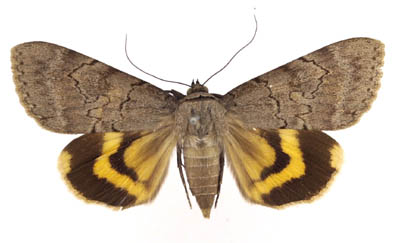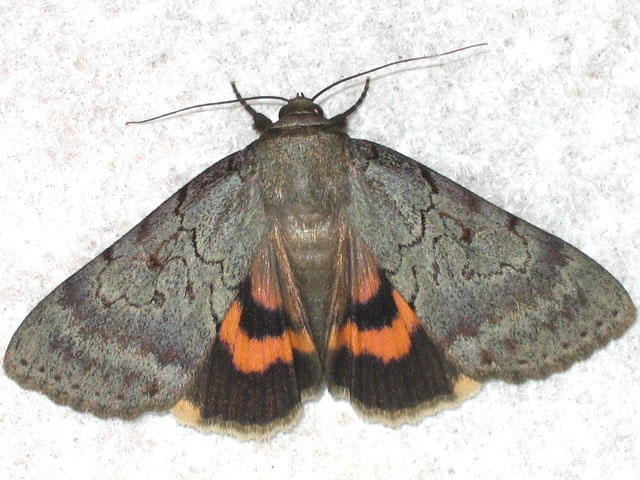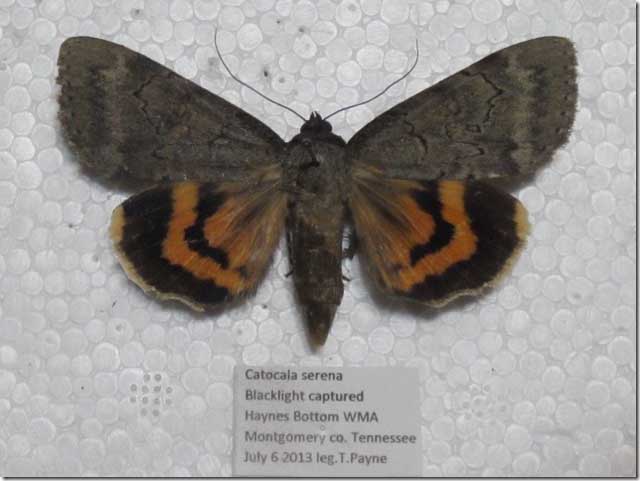|
|
Updated as per Wayne A. Miller's paper "Catocala (Noctuidae) Species taken in Clay County, Tennessee", October 2008, via Harry D. King.
Updated as per personal communication with Mark Etheridge, Myersville, Frederick County, Maryland, August 16, 2003; November 2009
Updated as per personal communication with Tom Nix, Dryden, Tompkins County, New York, August 27-28; September 15, 2013
|
Catocala serena
Catocala serena
kah-TOCK-uh-lahMsih-REE-nuh
Edwards, 1864

The Serene Underwing, Northeast Wisconsin, Calumet County,
July 28, 2006, courtesy of Carroll Rudy, digital repair to thorax (B. Oehlke).
This site has been created by Bill Oehlke at oehlkew@islandtelecom.com
Comments, suggestions and/or additional information are welcomed by Bill.
| TAXONOMY:
Superfamily: Noctuoidea
Family: Noctuidae
Group: Noctuinina
Subfamily: Catocalinae
Genus: Catocala, Schrank, 1802
| |
MIDI MUSIC
"Moon River"
copyright C. Odenkirk
MIDI CITYON.OFF
<bgsound src="moon.mid" LOOP=FOREVER>
|
DISTRIBUTION: Catocala serena
(wingspan: 55-60mm) flies in southern
Ontario (MB), New York (HM/TN),
New Jersey (JG),
Connecticut, as far south as to at least Tennessee (WAM),
and west to Pennsylvania, Illinois (BG) and at least
as far west as eastern Wisconsin (CR).
It has also been recorded in
Arkansas,
District of Columbia,
Georgia,
Indiana,
Iowa,
Kansas,
Kentucky,
Maryland (ME),
Massachusetts,
Michigan,
Minnesota,
Mississippi,
Missouri,
Nebraska,
New Hampshire,
North Carolina,
Ohio,
Oklahoma,
South Carolina,
Virginia and
West Virginia.
The head and collar and abdomen are brown while the thorax is grey. The black marginal band of the lower wings is indented at the center,
and the relatively narrow, deep yellow median band parallels this indentation.
Basal hairs are brown. |

Canadian Biodiversity Information Facility |

Catocala serena Stillwater
Township, Sussex County, New Jersey,
July 20, 2006,
courtesy of Joe Garris.
The pm line seems relatively distant from the outer margin in this species and meets the inner margin relatively close to the am line.
The reniform spot is hard to distinguish. The subreniform spot is large and frequently open.
The pm line does not have the elongated "teeth" typical of many other Catocala species. Both
the am and pm lines are thin, black and distinct on an otherwise relatively even grey (with a slight tinge of green) ground colour.
The hindwing fringe is pale orange and is not checked.

Catocala serena, Windsor, Ontario, coourtesy of Maurice Bottos.
FLIGHT TIMES AND PREFERRED FOOD PLANTS:
Catocala serena flies as a single generation with moths on the wing from July to September.
The Catocala serena caterpillar shows a preference for Carya ovata (shagbark hickory) and Juglans nigra (Black walnut).
Moths come in to lights and to bait.
Visit Catocala serena, Dryden, Tompkins County, New York, August 27-28, 2013, Tom Nix.

Catocala serena, Myersville, Frederick County, Maryland,
August 16, 2003, light, Mark Etheridge.

Catocala serena, Haynes Bottom WMA, Montgomery County, Tennessee,
July 6, 2013, courtesy of Thomas Payne, slight digital repair by Bill Oehlke.
ECLOSION:
Adults eclose from pupae formed under leaf litter.
SCENTING AND MATING:
Catocala serena females emit an airbourne pheromone and males use their antennae to track the scent plume.
EGGS, CATERPILLARS, COCOONS AND PUPAE:
Eggs are deposited on tree bark in the fall and hatch the following spring.
Mature larvae Image courtesy of |
|
Larval Food Plants
Listed below are primary food plant(s) and alternate food plants. It is hoped that this alphabetical listing followed by the common
name of the foodplant will prove useful. The list is not exhaustive, although some species seem very host specific.
Experimenting with closely related foodplants is worthwhile.
Carya ovata
Juglans nigra......
|
Shagbark hickory
Black walnut
|
Use your browser "Back button to return to the previous page.
Goto Main Catocala Index
This page is brought to you by Bill Oehlke and the
WLSS. Pages are on space rented from Bizland. If you would like to become a "Patron of the Sphingidae/Catocala Sites",
contact Bill.
Please send sightings/images to Bill. I will do my best to respond to requests for identification help.
Enjoy one of nature's wonderments: Live Saturniidae (Giant Silkmoth) cocoons.

|

To show appreciation for this site, click on the flashing
butterfly to the left, a link to many worldwide insect sites. |







